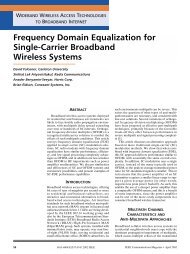Image Reconstruction for 3D Lung Imaging - Department of Systems ...
Image Reconstruction for 3D Lung Imaging - Department of Systems ...
Image Reconstruction for 3D Lung Imaging - Department of Systems ...
Create successful ePaper yourself
Turn your PDF publications into a flip-book with our unique Google optimized e-Paper software.
elying on a variational statement. This approach can be used to extend the finite<br />
element method to problems where no functional is available. The method <strong>of</strong> weighted<br />
residuals is widely used to derive element properties <strong>for</strong> non-structural applications<br />
such as heat transfer and fluid mechanics.<br />
Regardless <strong>of</strong> the particular finite element method selected, the solution <strong>of</strong> a continuum<br />
problem by the finite element method proceeds with following general sequence <strong>of</strong><br />
operations:<br />
1. Discretize the continuum. The FE method consists <strong>of</strong> discretizing the spatial domain,<br />
denoted Ω, into a number <strong>of</strong> non-uni<strong>for</strong>m, non-overlapping, elements connected<br />
via nodes. Triangles and rectangles are used in 2D problems while tetrahedral and<br />
hexahedral elements are used <strong>for</strong> <strong>3D</strong>. Additionally meshes using a mixture <strong>of</strong> different<br />
types <strong>of</strong> elements are possible. In this thesis only simplices (triangles <strong>for</strong> 2D and<br />
tetrahedrons <strong>for</strong> <strong>3D</strong>) are used. Figure 2.5(a) shows a 2D mesh constructed <strong>of</strong> triangles<br />
while figure 2.5(b) is a <strong>3D</strong> mesh constructed <strong>of</strong> tetrahedrons.<br />
(a) 2D Mesh with 256 Elements (b) <strong>3D</strong> Mesh with 21504 Elements<br />
Figure 2.5: Example 2D and <strong>3D</strong> discretizations<br />
2. Select interpolation functions. The field variable is approximated within each element<br />
by an interpolating function that is defined by the values <strong>of</strong> the field variable at<br />
the nodes <strong>of</strong> the element. Interpolation functions can be any piecewise polynomial<br />
function defined at a number <strong>of</strong> nodes. Linear interpolation functions are used <strong>for</strong><br />
most <strong>of</strong> the work in this thesis. Other interpolation functions have been used with<br />
EIT, <strong>for</strong> example Marko et al use quadratic interpolation functions in [116].<br />
3. Find the element properties. This means calculating the local matrix <strong>for</strong> each element.<br />
The symbol Y with appropriate subscripts is used to denote the components <strong>of</strong> local<br />
matrices throughout this thesis.<br />
4. Assemble the element properties to obtain a system equations. This means combining<br />
the local matrices into a single master or global matrix. The symbol Y or A without<br />
subscripts are used throughout to denote the global matrix.<br />
5. Impose the Boundary Conditions (BC). Boundary conditions can be fixed (also known<br />
as Type I, Dirichlet, or essential boundary conditions), derivative (also known as Type<br />
14





